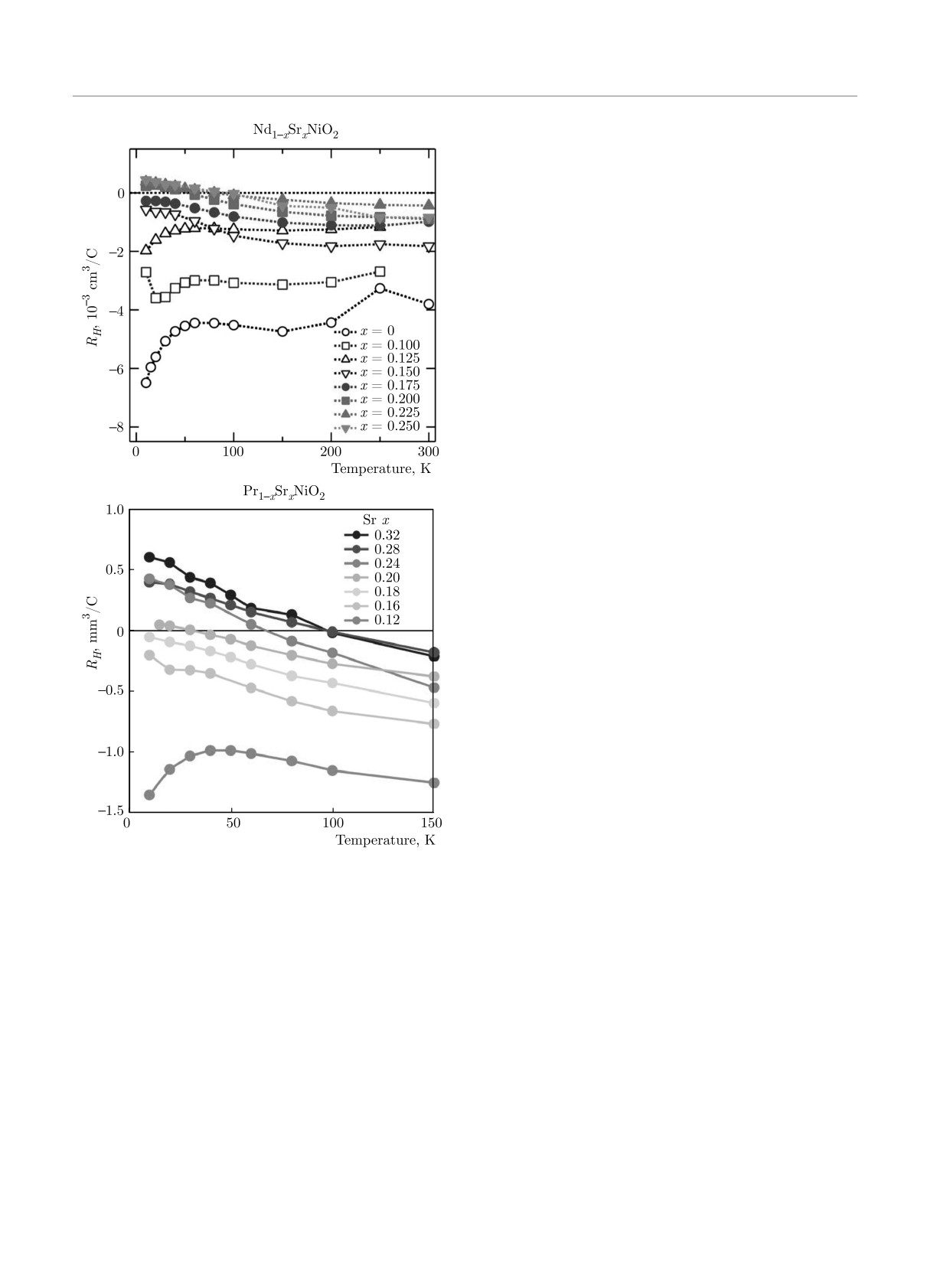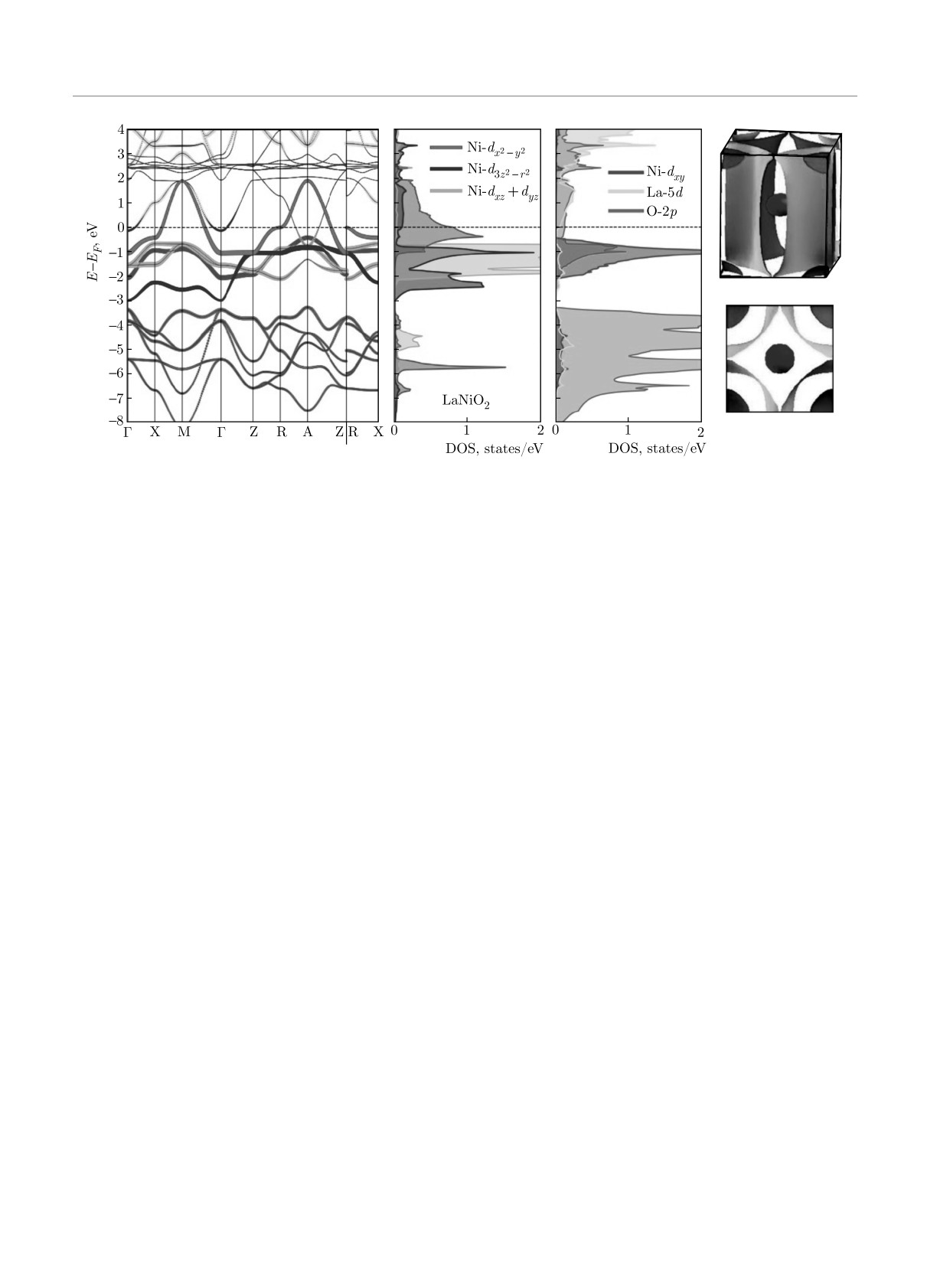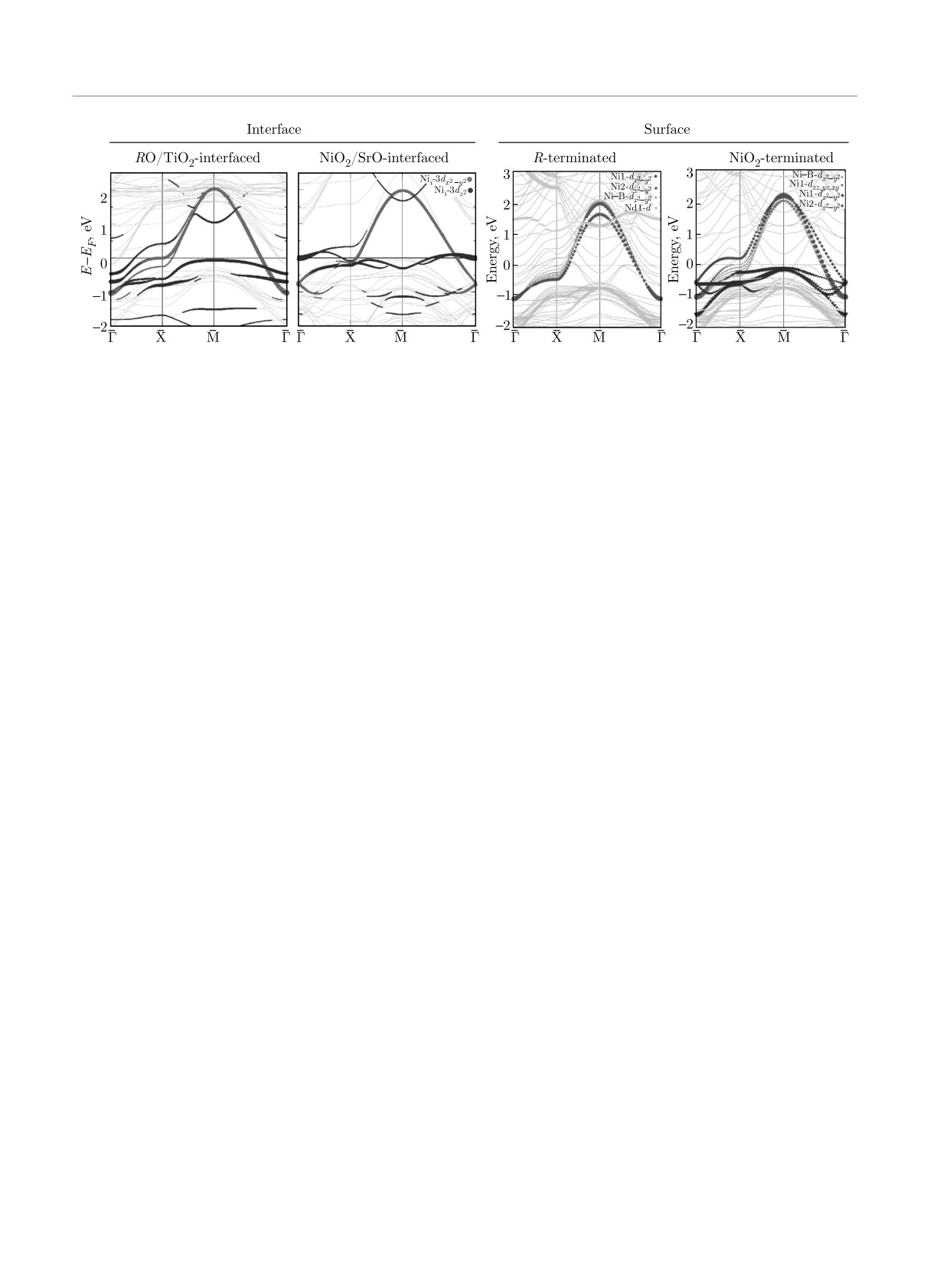ЖЭТФ, 2021, том 159, вып. 4, стр. 711-718
© 2021
NICKELATE SUPERCONDUCTORS: AN ONGOING DIALOG
BETWEEN THEORY AND EXPERIMENTS
A. S. Botanaa, F. Bernardinib, A. Canoc*
a Department of Physics, Arizona State University
Tempe, AZ 85287, USA
b Dipartimento di Fisica, Università di Cagliari
IT-09042, Monserrato, Italy
c Université Grenoble Alpes, CNRS, Grenoble INP, Institut Néel
38042, Grenoble, France
Received December 4, 2020,
revised version December 4, 2020
Accepted for publication December 5, 2020
Contribution for the JETP special issue in honor of I. E. Dzyaloshinskii’s 90th birthday
DOI: 10.31857/S0044451021040131
Unconventional superconductivity, understood
as superconductivity beyond the electron-phonon
paradigm, remains a defining problem in condensed
matter [1]. The challenge is exemplified by the high-Tc
cuprates, and nickelates joined the club last year after
Hwang and collaborators reported superconductivity
Fig. 1. Ball-and-stick model of the unit cell of the infinite-
in Sr-doped NdNiO2 thin films [2]. Here, we provide
layer nickelates RNiO2 and sketch of the formal 3d9 electronic
configuration of a Ni1+ atom in square-planar coordination.
an overview on nickelate superconductors.
The set of d orbitals is frequently divided into the subsets
Experimental facts. Rare-earth infinite-layer
eg-like = {dx2-y2 , dz2 } and t2g-like = {dxy, dxz, dyz} as in
octahedral coordination
nickelates RNiO2 have been known for decades [3-6].
This special type of nickelates can be seen as the n = ∞
members of the series Rn+1NinO2n+2, with each mem-
ber containing n-NiO2 planes (see Fig. 1, R — ra-
Figure 2 shows the temperature-composition phase
re-earth). The synthesis of these materials is typically
diagram of Sr-doped NdNiO2 and PrNiO2 [13,14]. The
achieved by first growing the nickelate in its RNiO3 per-
measured resistivity as a function of temperature shows
ovskite version, and then removing the apical oxygens
metallic behavior, with a low-temperature upturn sys-
from the NiO6 octahedra with reducing agents such as
tematically observed (Fig.
2). This upturn can be
hydrogen [7]. This is the so-called topotactic reduction
attributed to weak localization, or it could be remi-
which, in practice, may have unwanted consequences
niscent of Kondo physics [15]. These systems can be
such as hydrogen intercalation into the sample [8]. Su-
seen as weak insulators or bad metals all along the
perconductivity in RNiO2 (R = Pr, Nd) emerges via
phase diagram, in marked contrast to cuprates. Be-
charge carrier doping as in the cuprates. This has only
sides, no signature of long-range magnetic order has
been achieved by means of thin-film growth techniques
been reported so far for the parent infinite-layer nick-
[9], while superconductivity in doped bulk samples is
elates [4, 5, 16]. However, a recent NMR study has
yet to be reported [10-12].
pointed out the presence of antiferromagnetic fluctu-
ations and quasi-static antiferromagnetic order below
* E-mail: andres.cano@neel.cnrs.fr
40 K in Nd0.85Sr0.15NiO2 [17].
711
A. S. Botana, F. Bernardini, A. Cano
ЖЭТФ, том 159, вып. 4, 2021
Fig. 2. Temperature vs composition phase diagram of the superconducting infinite-layer nickelates reported so far — i. e. Sr-do-
ped NdNiO2 and PrNiO2 thin films on SrTiO3 substrates — and corresponding resistivity data (from [13] and [14]). Sr-doping
is equivalent to hole doping in these systems. The superconducting Tc reaches 15 K in the best superconducting samples. The
resistivity in the normal state shows metallic behavior as a function of temperature, with a Kondo-like upturn systematically
observed for both underdoped and overdoped samples. The metallicity is however rather poor, and hence these systems can
be seen as bad metals with weakly insulating features. At the same time, enhanced metallicity has been repeatedly reported in
superconducting samples when compared to the non-superconducting ones
The transport data reported so far is still sample de-
found to be inhomogenous, with different features at
pendent, with nominally equivalent samples displaying
different locations of the sample. One of the predomi-
finite resistivity or a complete drop [13, 18, 19]. Also,
nant features correspond to a V-shape spectrum. How-
whether the original LaNiO2 reference compound hosts
ever, features corresponding to a full s-wave gap are
superconductivity or not remains an important open
equally observed and, in some cases, even a mixture of
question. This difference may be “simply” due to sam-
the two.
ple quality and/or the presence of topotactic hydrogen
in LaNiO2 — i. e. the formation of LaNiO2H instead
Theoretical considerations.
of LaNiO2 [8]. Otherwise, it may be more intrinsically
related to the rare-earth elements themselves — i. e.
Single-particle picture. At the single-particle DFT
closed vs open 4f shells and the corresponding mag-
level, the calculations support the multiband picture
netic moments.
of the infinite-layer nickelates in agreement with exper-
imental data [20, 24-34]. These calculations reveal a
Figure 3 illustrates the measured Hall coefficient
large Fermi-surface sheet due to Ni-3dx2-y2 holes akin
for RNiO2 that has been observed to change sign
to that in cuprates (see Fig. 4). However, the Fermi
both as a function of temperature and as a function
surface displays additional electron pockets due to 5d
of doping. This evidences an underlying multiband
states associated to the rare-earth 5d states (5dz2 at
character in infinite-layer nickelates, which is another
Γ and 5dxy at A). This can be seen as a self-doping
important fundamental difference when compared to
effect promoted by the hybridization of these formally
cuprates. Such a multiband picture has been con-
empty states with the Ni-3d bands. This effect is to-
firmed by X-ray spectroscopic techniques [20-22]. How-
tally absent in the cuprates. Moreover, the Ni-3dz2
ever, in contrast to the Hall data, the changes in the
states turn out to be partially occupied and addition-
X-ray spectra observed as a function of Sr-doping have
ally hybridized with the R-5d ones. Thus, the full eg-li-
been interpreted in terms of doped holes residing in the
ke = {dx2-y2 , dz2 } sector of the Ni-3d states becomes
Ni-3dx2-y2 orbitals without necessarily invoking multi-
“active” in infinite-layer nickelates. In part, this results
band effects [21].
from the comparatively large difference in on-site ener-
The single particle tunneling spectrum has been
gies promoting charge from O-2p to Ni-3d orbitals, i. e.
measured on (Nd,Sr)NiO2 [23]. The spectrum was
the so-called charge-transfer energy ∼ 4 eV.
712
ЖЭТФ, том 159, вып. 4, 2021
Nickelate superconductors: an ongoing dialog. ..
argued to drive the Cooper pairing in these systems
[26, 27, 36, 37]. Specifically, d-wave superconductivity
was concluded from complementary random phase ap-
proximation (RPA) and fluctuation exchange (FLEX)
calculations for many-body multi-orbital Hamiltonians
in which the non-interacting part maps the relevant
DFT bands. More recently, these results have been con-
firmed using advanced techniques in which the starting
vertex is non-perturbative so that the local correlations
are fully included [38].
The same conclusion about the d-wave symmetry
of the superconducting gap was reached in [27] from a
standard t-J model constructed in a similar way for the
Ni-3dx2-y2 states. Further, the specific self-doping fea-
tures of the nickelates have inspired an extended t-J
model that generically addresses the strong-coupling
limit of similar multiband systems [39]. Alternatively,
if the Hund’s coupling J between dx2-y2 and dz2 Ni
orbitals plays a dominant role, it has been pointed out
that the Cooper pairing can be interpreted within a
spin-freezing scenario as due to local-moment fluctu-
ations, rather than to pure antiferromagnetic fluctua-
tions [40].
Many-body correlation effects: Electronic structure.
The DFT picture has been revised using many-body
perturbation theory at the GW level, thus treating cor-
relations ab initio [41,42]. The low-energy physics re-
mains essentially unaffected, with only small changes
obtained in the interacting Fermi surface and in the
quasiparticle spectral weights near the Fermi level.
The Ni-3dx2-y2 bandwidth reduces slightly while the
Ni-3dz2 one increases as the O-2p states are further
shifted to lower energies (1.5 eV further down from
the Fermi level) [41]. The latter, however, represents
a rather substantial change, and hence suggests that
the canonical charge-transfer-insulator picture is even
Fig. 3. Hall coefficient RH measured in NdNiO2 and PrNiO2
more unlikely for the infinite-layer nickelates in the GW
as a function of temperature and Sr doping [13,14]. In both
cases, the Hall coefficient below 100 K changes sign as a func-
framework. These changes are also tied to an impor-
tion of Sr content (x in R1-xSrxNiO2). The main charge car-
tant shift of the empty 4f states [41], which should be
riers have electron character in the parent compounds (x = 0),
taken as a warning regarding their role in the overall
which eventually changes to holes upon increasing doping.
physics of these materials.
This was the first experimental hint of an underlying multi-
band picture
DFT+DMFT (dynamical mean-field theory) calcu-
lations according to Hubbard-Hund interaction Hamil-
tonians have been performed to further scrutinize the
correlated nature of the different orbitals and clarify
Many-body correlation effects: Cooper pairing. The
the multiband nature in RNiO2 [15, 35, 38, 40, 43-51].
standard electron-phonon mechanism has been ruled
In addition, DMFT has also been applied in combi-
out as the main reason for superconductivity in infini-
nation with the quasiparticle self-consistent GW ap-
te-layer nickelates [28].
Instead, repulsive interac-
proximation in a parameter-free fashion [42, 52]. The
tions mediated by spin-fluctuations were right away
overall multiband picture remains robust and the re-
713
A. S. Botana, F. Bernardini, A. Cano
ЖЭТФ, том 159, вып. 4, 2021
Fig. 4. Electronic structure of the reference material LaNiO2 obtained at the DFT level (fat-band plot, density of states (DOS)
and Fermi surface from [25] and [35]). In addition to the main Ni-3dx2-y2 cuprate-like band crossing the Fermi level, the Ni-3dz2
states are not completely occupied in these systems. Further, the system has a multiband character due to La-5d states that
give rise to additional electron pockets and “self-dope” the Ni-3dx2-y2 hole-like Fermi surface. The O-2p states, in turn, are
comparatively far below the Fermi level
sults confirm the above trends. However, the effective
ble to spin-density disproportionation, breathing and
mass renormalization or inverse quasiparticle weight
half-breathing lattice distortions, and charge-density
m∗/m = 1/Z undergoes substantial orbital-selective
disproportionation. A different point of view suggests
changes [35, 44, 46]. The Ni-dx2-y2 band is found to
that 5d conduction electrons could screen the Ni spins,
have a tendency towards localization such that a Mott
suppressing magnetism and giving rise to a Kondo ef-
gap can eventually open if the Hubbard interaction is
fect like that seen in heavy fermion materials [15]. Be-
large enough [44, 45]. The R-5d self-doping bands, in
yond that, an intrinsic difference that could be be-
contrast, remain much more weakly correlated [44,45].
hind the differing properties across the RNiO2 series,
Beyond that, the DMFT results define an apparent
notably the emergence of superconductivity itself, is
Hubbard vs Hund dichotomy in which the multiband
the presence/absence of magnetic rare-earth elements
aspects of infinite-layer nickelates are emphasized dif-
[33, 59].
ferently [53].
Interfacial and surface effects. The local elec-
Magnetism. A magnetic ground state is consis-
tronic properties of the infinite-layer nickelate thin
tently obtained in theoretical studies [20, 24, 25, 48, 49,
films were first addressed in [60] and shortly after in
53-57]. In DFT+DMFT a near degeneracy of spin or-
[61]. The epitaxial growth of the RNiO2/SrTiO3 het-
ders is obtained that implies magnetic frustration es-
erostructures can in principle yield different atomic
pecially upon doping [48, 49]. This frustration arises
boundaries between the sample and the substrate [60].
due to the involvement of both 3dx2-y2 and 3dz2 Ni
The most obvious configuration corresponds to a fully
orbitals and may be responsible for the experimental
reduced nickelate having its (RO →) R layer directly on
suppression of long-range magnetic order. A comple-
top of the TiO2-terminated substrate. This configura-
mentary point of view is obtained via DFT calcula-
tion, however, was found to be energetically unstable,
tions, as the antiferromagnetic ground state portrays a
which is a local-scale manifestation of the thermody-
one-dimensional-like van Hove singularity of dz2 char-
namic fragility of these phases. Thus, the infinite-layer
acter pinned at the Fermi level [58]. This singularity
nickelate prefers to face a RO layer to the substrate,
makes the antiferromagnetic phase eventually unsta-
and the same conclusion holds even for a direct-growth
714
ЖЭТФ, том 159, вып. 4, 2021
Nickelate superconductors: an ongoing dialog. ..
Fig. 5. Electronic band structure of the infinite-layer nickelates at the RNiO2/SrTiO3 interface (left) and at the surface (right)
for different atomic configurations (the colors highlight the main contributions of the interfacial/surface Ni-3d states near the
Fermi level; adapted from [60] and [62]). In both cases the nature of the self-doping effect — obtained from the R-5d states in
the bulk — changes or even disappear depending on the local atomic configuration. At the same time, other Ni-3d states are
pushed closer to the Fermi level and locally supplement the system with flat band features
process. This “chemical” reconstruction was further
considered at the DFT+U level [63]. This enhances
shown to produce drastic changes in the electronic
the itineracy of the Ni-3dz2 orbitals at the interface
structure at the interface [60]. The interfacial chemical
with the substrate, while the magnetism is essentially
reconstruction according to the R → Sr → RO → SrO
suppressed at the surface to vacuum. Further, the ef-
sequence is to some extent equivalent to localized hole
fect of the nickelate termination anticipated in [60] is
doping. This local doping was found to deplete the
specifically considered in relation to superconductivity
self-doping R-5d states at the interface. Specifically,
in [62]. Thus, it is argued that the d-wave supercon-
the R-5d states are first replaced by Ti-3d ones, which
ducting gap expected for the bulk may transform into
are then pushed above the Fermi level for the SrO con-
a s±-wave one at the NiO2-terminated surface, and it
figuration (see Fig. 5). At the same time, the intefacial
is also suggested that a surface s + id-wave state may
Ni-3dz2 states are driven closer to the Fermi energy
be realized under the appropriate conditions.
so that they manifestly participate in the low-energy
physics. Thus, the Kondo-lattice features are expected
Conclusions and perspectives. The recent dis-
to be fundamentally different at the interfaces where,
covery of superconductivity in infinite-layer nickelates
in addition, the Ni-eg sector will likely be fully ac-
has created intense excitement. These systems have
tive. Besides, this sector is supplemented by a markedly
been rapidly scrutinized from many different angles,
flat band character of the interfacial Ni-3dz2 states, so
using a battery of experimental and theoretical tools.
that interface-specific correlation effects may be pro-
The initial motivation of drawing analogies with the
moted [60].
high-Tc cuprates has thus been surpassed. Instead, the
accumulated results have now consolidated these sys-
This picture was subsequently confirmed for thin
tems as a new class of unconventional superconducting
films with asymmetric boundaries [61, 63, 64]. In that
materials.
case, the different polar discontinuities yield an effec-
tive built-in electric field across the film and polar lay-
Specifically, the rare-earth infinite-layer nickelates
ers can be formed at the surface and at the interface
have been confirmed to host a distinct multiband in-
[63]. These layers show antiparallel NiO2 displace-
terplay, on top of which electronic correlations build
ments, but otherwise are decoupled. At the interface
and determine the main properties of these systems.
with the substrate, a two-dimensional electron gas ex-
This interplay is present already within the Ni sector
tending over several layers together with the aforemen-
itself, as not only the Ni-3dx2-y2 states but also the
tioned depletion of the self-doping R-5d states is ob-
Ni-3dz2 ones are found to be active. This further intro-
tained [61, 63]. In addition, the combined effect of
duces specific correlation effects and the bad metallic,
magnetism (G-AFM order) and correlations has been
or weakly insulating behavior is now understood as a
715
A. S. Botana, F. Bernardini, A. Cano
ЖЭТФ, том 159, вып. 4, 2021
direct manifestation of these correlations. However, a
Funding. A. B. acknowledges the support from
Hubbard vs Hund dichotomy has emerged that is yet to
NSF DMR 2045826.
be clarified. In addition, the rare-earth states introduce
extra specific ingredients such as the self-doping effect
The full text of this paper is published in the English
and a 4f-ness that may qualitatively be even more im-
version of JETP.
portant. When it comes to the central question, that
is, the emergence of superconductivity in these mate-
rials, it has been ascribed to spin fluctuations (in a
REFERENCES
broad sense), and there is now experimental evidence
1.
M. R. Norman, Science 332, 196 (2011).
of incipient antiferromagnetic order.
2.
D. Li, K. Lee, B. Y. Wang, M. Osada, S. Crossley,
Additional progress to further clarify these aspects,
H. R. Lee, Y. Cui, Y. Hikita, and H. Y. Hwang, Na-
as well as the actual superconducting properties be-
ture (London) 572, 624 (2019).
yond Tc can be naturally expected [65]. In this con-
3.
M. Crespin, P. Levitz, and L. Gatineau, J. Chem.
text, it is fundamental to determine whether the lack
Soc., Faraday Trans. 2 79, 1181 (1983).
of superconductivity in the LaNiO2 reference material
is intrinsic and also why thin films are superconducting
4.
M. Hayward, M. Green, M. Rosseinsky, and J. Sloan,
while bulk samples are not.
J. Amer. Chem. Soc. 121, 8843 (1999).
5.
M. Hayward and M. Rosseinsky, Sol. St. Sci. 5, 839
More importantly, a crucial issue to address is:
(2003).
is there a whole new family of nickel-based uncon-
ventional superconductors waiting to be discovered?
6.
M. Crespin, O. Isnard, F. Dubois, J. Choisnet, and
This question currently motivates the experimental
P. Odier, J. Sol. St. Chem. France 178, 1326 (2005).
and computational search of new alternative mate-
7.
A. Ikeda, T. Manabe, and M. Naito, Physica C 506,
rials [66-74]. Other layered nickelates are obtained
83 (2014).
via oxygen reduction from the corresponding Ruddles-
den-Popper phases [75,76]. The n = 2 and 3 materials,
8.
L. Si, W. Xiao, J. Kaufmann, J. M. Tomczak, Y. Lu,
in particular, have been known for a while and, simi-
Z. Zhong, and K. Held, Phys. Rev. Lett. 124, 166402
larly to the n = ∞ ones, have also been discussed as
(2020).
candidate superconductors [66-71, 77]. Recently, La-
9.
K. Lee, B. H. Goodge, D. Li, M. Osada, B. Y. Wang,
based n = 4-6 parent Ruddlesden-Popper phases have
Y. Cui, L. F. Kourkoutis, and H. Y. Hwang, APL
also been synthesized [78]. Reduction of these com-
Mater. 8, 041107 (2020).
pounds is particularly promising as they would reali-
ze d-electron counts that can be directly mapped into
10.
Q. Li, C. He, J. Si, X. Zhu, Y. Zhang, and H.-H. Wen,
Commun. Mater. 1, 16 (2020).
the dome area of filling. In addition, current epitaxial
growth techniques can be exploited as an alternative
11.
B.-X. Wang, H. Zheng, E. Krivyakina, O. Chmais-
route to engineer Ni-based heterostructures mimicking
sem, P. P. Lopes, J. W. Lynn, L. C. Gallington,
the Rn+1NinO2n+2 series with the advantage of better
Y. Ren, S. Rosenkranz, J. F. Mitchell, and D. Phelan,
sample quality and doping control [60]. The infinite-
Phys. Rev. Mater. 4, 084409 (2020).
layer case itself has proven to be a challenging but suc-
12.
C. He, X. Ming, Q. Li, X. Zhu, J. Si, and H.-H. Wen,
cessful example in this respect.
arXiv:2010.11777.
Shedding light on these issues will not only help
13.
D. Li, B. Y. Wang, K. Lee, S. P. Harvey, M. Osada,
understanding superconductivity in these specific
B. H. Goodge, L. F. Kourkoutis, and H. Y. Hwang,
low-valence layered nickelates but will also provide
Phys. Rev. Lett. 125, 027001 (2020).
new perspectives about the nature of unconventional
14.
M. Osada, B. Y. Wang, K. Lee, D. Li, and
superconductivity in general.
H. Y. Hwang, arXiv:2010.16101.
15.
G.-M. Zhang, Y.-F. Yang, and F.-C. Zhang, Phys.
Acknowledgments. We dedicate this review on
Rev. B 101, 020501 (2020).
this 1-year-old topic to I. E. Dzyaloshinskii in celebra-
tion of his 90th birthday. We thank M. R. Norman and
16.
A. Ikeda, Y. Krockenberger, H. Irie, M. Naito, and
X. Blase for useful comments.
H. Yamamoto, Appl. Phys. Express 9, 061101 (2016).
716
ЖЭТФ, том 159, вып. 4, 2021
Nickelate superconductors: an ongoing dialog. ..
17.
Y. Cui, C. Li, Q. Li, X. Zhu, Z. Hu, Y.-F. Yang,
31.
E. Been, W.-S. Lee, H. Y. Hwang, Y. Cui, J. Zaa-
J. S. Zhang, R. Yu, H.-H. Wen, and W. Yu, arXiv:
nen, T. Devereaux, B. Moritz, and C. Jia, arXiv:2002.
2011.09610.
12300.
18.
S. Zeng, C. S. Tang, X. Yin, C. Li, M. Li,
32.
F. Bernardini, V. Olevano, and A. Cano, Phys. Rev.
Z. Huang, J. Hu, W. Liu, G. J. Omar, H. Jani,
Res. 2, 013219 (2020).
Z. S. Lim, K. Han, D. Wan, P. Yang, S. J. Pennycook,
33.
J. Kapeghian and A. S. Botana, Phys. Rev. B 102,
A. T. S. Wee, and A. Ariando, Phys. Rev. Lett. 125,
205130 (2020).
147003 (2020).
34.
J. Krishna, H. LaBollita, A. O. Fumega, V. Pardo,
19.
M. Osada, B. Y. Wang, B. H. Goodge, K. Lee,
and A. S. Botana, Phys. Rev. B 102, 224506 (2020).
H. Yoon, K. Sakuma, D. Li, M. Miura, L. F. Kour-
koutis, and H. Y. Hwang, Nano Lett. 20, 5735 (2020).
35.
Y. Wang, C.-J. Kang, H. Miao, and G. Kotliar, Phys.
Rev. B 102, 161118 (2020).
20.
M. Hepting, D. Li, C. J. Jia, H. Lu, E. Paris,
Y. Tseng, X. Feng, M. Osada, E. Been, Y. Hikita,
36.
T. Zhou, Y. Gao, and Z. Wang, Sci. China Phys.
Y. D. Chuang, Z. Hussain, K. J. Zhou, A. Nag,
Mech. Astron. 63, 287412 (2020).
M. Garcia-Fernandez, M. Rossi, H. Y. Huang,
D. J. Huang, Z. X. Shen, T. Schmitt, H. Y. Hwang,
37.
P. Adhikary, S. Bandyopadhyay, T. Das, I. Dasgupta,
B. Moritz, J. Zaanen, T. P. Devereaux, and W. S. Lee,
and T. Saha-Dasgupta, Phys. Rev. B 102, 100501
Nature Mater. 19, 381 (2020).
(2020).
21.
M. Rossi, H. Lu, A. Nag, D. Li, M. Osada, K. Lee,
38.
M. Kitatani, L. Si, O. Janson, R. Arita, Z. Zhong,
B. Y. Wang, S. Agrestini, M. Garcia-Fernandez,
and K. Held, npj Quant. Mater. 5, 59 (2020).
Y. D. Chuang, Z. X. Shen, H. Y. Hwang, B. Moritz,
39.
Y.-H. Zhang and A. Vishwanath, Phys. Rev. Res. 2,
K.-J. Zhou, T. P. Devereaux, and W. S. Lee,
023112 (2020).
arXiv:2011.00595.
40.
P. Werner and S. Hoshino, Phys. Rev. B 101, 041104
22.
B. H. Goodge, D. Li, M. Osada, B. Y. Wang, K. Lee,
(2020).
G. A. Sawatzky, H. Y. Hwang, and L. F. Kourkoutis,
arXiv:2005.02847.
41.
V. Olevano, F. Bernardini, X. Blase, and A. Cano,
Phys. Rev. B 101, 161102 (2020).
23.
Q. Gu, Y. Li, S. Wan, H. Li, W. Guo, H. Yang,
Q. Li, X. Zhu, X. Pan, Y. Nie, and H.-H. Wen,
42.
F. Petocchi, V. Christiansson, F. Nilsson, F. Aryase-
arXiv:2006.13123.
tiawan, and P. Werner, arXiv:2006.00394.
24.
K.-W. Lee and W. E. Pickett, Phys. Rev. B 70,
43.
S. Ryee, H. Yoon, T. J. Kim, M. Y. Jeong, and
165109 (2004).
M. J. Han, Phys. Rev. B 101, 064513 (2020).
25.
A. S. Botana and M. R. Norman, Phys. Rev. X 10,
44.
F. Lechermann, Phys. Rev. B 101, 081110 (2020).
011024 (2020).
45.
J. Karp, A. S. Botana, M. R. Norman, H. Park,
26.
H. Sakakibara, H. Usui, K. Suzuki, T. Kotani,
M. Zingl, and A. Millis, Phys. Rev. X 10, 021061
H. Aoki, and K. Kuroki, Phys. Rev. Lett. 125, 077003
(2020).
(2020).
46.
I. Leonov, S. L. Skornyakov, and S. Y. Savrasov,
27.
X. Wu, D. Di Sante, T. Schwemmer, W. Hanke,
Phys. Rev. B 101, 241108 (2020).
H. Y. Hwang, S. Raghu, and R. Thomale, Phys. Rev.
47.
F. Lechermann, Phys. Rev. X 10, 041002 (2020).
B 101, 060504 (2020).
48.
I. Leonov and S. Y. Savrasov, arXiv:2006.05295.
28.
Y. Nomura, M. Hirayama, T. Tadano, Y. Yoshi-
moto, K. Nakamura, and R. Arita, Phys. Rev. B 100,
49.
X. Wan, V. Ivanov, G. Resta, I. Leonov, and
205138 (2019).
S. Y. Savrasov, arXiv:2008.07465.
29.
J. Gao, S. Peng, Z. Wang, C. Fang, and H. Weng,
50.
C.-J. Kang and G. Kotliar, arXiv:2007.15383.
nwaa218, nwaa218.
51.
Z.-J. Lang, R. Jiang, and W. Ku, arXiv:2005.00022.
30.
P. Jiang, L. Si, Z. Liao, and Z. Zhong, Phys. Rev.
52.
B. Kang, C. Melnick, P. Semon, G. Kotliar, and
B 100, 201106 (2019).
S. Choi, arXiv:2007.14610.
717
A. S. Botana, F. Bernardini, A. Cano
ЖЭТФ, том 159, вып. 4, 2021
53.
F. Lechermann, arXiv:2012.09796.
68.
V. V. Poltavets, K. A. Lokshin, M. Croft, T. K. Man-
dal, T. Egami, and M. Greenblatt, Inorg. Chem. 46,
54.
H. Zhang, L. Jin, S. Wang, B. Xi, X. Shi, F. Ye, and
10887 (2007).
J.-W. Mei, Phys. Rev. Res. 2, 013214 (2020).
69.
V. V. Poltavets, K. A. Lokshin, S. Dikmen, M. Croft,
55.
Y. Gu, S. Zhu, X. Wang, J. Hu, and H. Chen, Com-
T. Egami, and M. Greenblatt, J. Amer. Chem. Soc.
mun. Phys. 3, 84 (2020).
128, 9050 (2006).
56.
Z. Liu, Z. Ren, W. Zhu, Z. Wang, and J. Yang, npj
Quant. Mater. 5, 31 (2020).
70.
V. V. Poltavets, M. Greenblatt, G. H. Fecher, and
C. Felser, Phys. Rev. Lett. 102, 046405 (2009).
57.
A. S. Botana and V. Pardo, arXiv:2012.02711.
71.
V. V. Poltavets, K. A. Lokshin, A. H. Nevidomskyy,
58.
M.-Y. Choi, K.-W. Lee, and W. E. Pickett, Phys.
M. Croft, T. A. Tyson, J. Hadermann, G. Van Ten-
Rev. Res. 2, 033445 (2020).
deloo, T. Egami, G. Kotliar, N. Aproberts-Warren,
A. P. Dioguardi, N. J. Curro, and M. Greenblatt,
59.
M.-Y. Choi, K.-W. Lee, and W. E. Pickett, Phys.
Phys. Rev. Lett. 104, 206403 (2010).
Rev. B 101, 020503 (2020).
60.
F. Bernardini and A. Cano, J. Phys. Mater. 3,
72.
J. Gawraczyński, D. Kurzydłowski, R. A. Ewings,
03LT01 (2020).
S. Bandaru, W. Gadomski, Z. Mazej, G. Rua-
ni, I. Bergenti, T. Jaroń, A. Ozarowski, S. Hill,
61.
B. Geisler and R. Pentcheva, Phys. Rev. B 102,
P. J. Leszczyński, K. Tokár, M. Derzsi, P. Barone,
020502 (2020).
K. Wohlfeld, J. Lorenzana, and W. Grochala, Proc.
Nat. Acad. Sci. 116, 1495 (2019).
62.
X. Wu, K. Jiang, D. Di Sante, W. Hanke, A. P. Schny-
der, J. Hu, and R. Thomale, arXiv:2008.06009.
73.
M. Hirayama, T. Tadano, Y. Nomura, and R. Arita,
63.
Y. Zhang, L.-F. Lin, W. Hu, A. Moreo, S. Dong, and
Phys. Rev. B 101, 075107 (2020).
E. Dagotto, Phys. Rev. B 102, 195117 (2020).
74.
F. Bernardini, V. Olevano, X. Blase, and A. Cano, J.
64.
R. He, P. Jiang, Y. Lu, Y. Song, M. Chen, M. Jin,
Phys. Mater. 3, 035003 (2020).
L. Shui, and Z. Zhong, Phys. Rev. B 102, 035118
(2020).
75.
Z. Z. MG Greenblatt and M. Whangbo, Synth. Met.
85, 1451 (1997).
65.
B. Y. Wang, D. Li, B. H. Goodge, K. Lee, M. Osa-
da, S. P. Harvey, L. F. Kourkoutis, M. R. Be-
76.
M. Greenblatt, Curr. Opin. Solid State Mater. Sci. 2,
asley, and H. Y. Hwang, Nature Phys.
(2021),
174 (1997).
2012.06560.
77.
J. Karp, A. Hampel, M. Zingl, A. S. Botana, H. Park,
M. R. Norman, and A. J. Millis, Phys. Rev. B 102,
66.
A. S. Botana, V. Pardo, and M. R. Norman, Phys.
245130 (2020).
Rev. Mater. 1, 021801 (2017).
78.
Z. Li, W. Guo, T. T. Zhang, J. H. Song, T. Y. Gao,
67.
J. Zhang, A. S. Botana, J. W. Freeland, D. Phelan,
Z. B. Gu, and Y. F. Nie, APL Mater. 8, 091112
H. Zheng, V. Pardo, M. R. Norman, and J. F. Mit-
(2020).
chell, Nature Phys. 13, 864 (2017).
718







